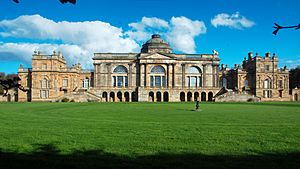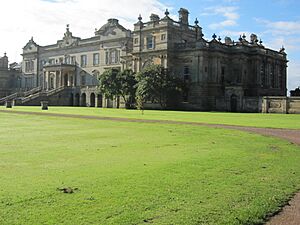Gosford House facts for kids
Gosford House is a grand country house built in the Neoclassical style. It is located about 2 miles (3.2 km) northeast of Longniddry in East Lothian, Scotland. The house sits within a huge park and coastal area that covers about 5,000 acres (2,023 hectares).
This impressive estate is the family home of the Charteris family, who are known as the Earls of Wemyss and March. It was once the home of the late David Charteris, the 12th Earl of Wemyss, who was also the chief of Clan Charteris. After he passed away in 2008, his son, James Charteris, became the 13th Earl. Even though James is the current Earl, he and his wife live at another family home called Stanway House in England. The south part of Gosford House is still used as the family's private living area.
Gosford House and its surrounding property are very important historically. Many buildings on the estate, including the main house, the stables, and a special family tomb called a mausoleum, are listed as "Category A" buildings. This means they are of great national importance. The beautiful gardens and designed landscapes around the house are also recognized as significant in Scotland.
Contents
The Story of Gosford House
Early Owners and Robert Adam's Design
Before the Charteris family owned Gosford House, it belonged to several different families over the centuries. These included the Murrays, Douglases, Sinclairs, Achesons, Auchmutys, and Wedderburns.
The 7th Earl of Wemyss, Francis Wemyss-Charteris, bought the property in the late 1700s. He decided to build the magnificent Gosford House between 1790 and 1800. The famous architect Robert Adam designed the house, but he sadly passed away before it was finished. The 7th Earl is buried in a unique pyramid-shaped tomb on the estate, which is also a Category A listed building. This tomb reflects his role as a Grand Master Mason.
Changes and Rebuilding Over Time
When the 8th Earl, Francis Douglas, inherited Gosford House, it had a main central block with two smaller wings connected by long walkways. However, the damp weather and the use of sea sand in the building materials caused damage. Because of this, the 8th Earl had to remove the wings in the 1800s.
Later, in 1891, the 10th Earl, Francis Charteris, decided to rebuild the wings. He hired an architect named William Young for this project. The south wing, which Young rebuilt, is home to the famous Marble Hall.
Gosford House in Recent Times
In the years between World War I and World War II, Gosford House was used as a hotel. During World War II, the British Army took over the house. Sadly, a fire broke out during a party, damaging part of the central area. This damage, along with a problem called dry rot, led to the roof being partly removed.
The house began to be restored in 1987 when a new roof was put on. The Dowager Countess of Wemyss and March, Shelagh, worked hard to restore the central part of the house. More recently, James Charteris, the 13th Earl, has continued the conservation work, including fixing damage from the Army's time there. He also restored the ponds in the grounds.
On a clear day, you can even see Gosford House from Edinburgh! The house is open to visitors during the summer months. The grounds also have a very rare and interesting building called a Scottish curling house, which was used for the sport of curling.
Inside Gosford House
A report from 1971 described Gosford House as a beautiful classical mansion with two main floors and a basement. It mentioned that William Young had replaced Robert Adam's original wings with more decorative ones in 1891. The report also noted that the house holds a wonderful collection of paintings and fine porcelain.
A publication from 2015 gave more details about the inside of the house. It said that the Marble Hall in the south wing is one of the most amazing features. This hall, finished in 1891, rises three stories high and has a magnificent double staircase. This staircase leads up to a gallery where paintings are displayed. The grand fireplace, tall alabaster columns, and fancy plasterwork show the 10th Earl's love for Italian design. The large windows, arranged in a Palladian style, also remind visitors of Robert Adam's first plans for the house.
Gosford House on Screen
Gosford House has been a popular location for filming movies and TV shows. It was used in the 2000 film House of Mirth, which was based on a novel by Edith Wharton. The house also appeared in the second and third seasons of Outlander, a popular TV series. You might also have seen it in the 2011 movie The Awakening.
See also



